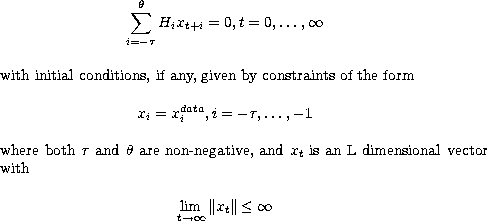AMA Code
Problem Statement
Characterize the dynamics of xt where

Anderson-Moore Algorithm Output Matrices
Q - Asymptotic Linear Constraints Matrix such that

for all xt satisfying the linear homogeneous system.
B - Autoregressive Representation Matrix

satisfies the linear homogeneous system and lim k
 ||xt+k|| <
||xt+k|| <  .
.
S - Observable Structure Matrix
determine the existence and uniqueness of an observable structure matrix, S such that

 ,
,  - Stochastic Transition Matrices
- Stochastic Transition Matrices

The SPSolve routine computes cof(for H), cofb(for B), scof(for S), dTrans(for ), and bTrans(for
), and bTrans(for  ).
).